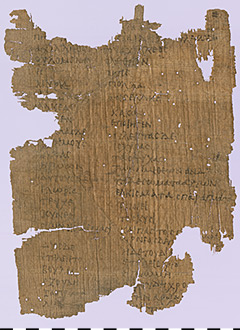P. 5014
Faust, Romeo and Juliet or even the songs of today’s stars – lyrical texts can sometimes be very confusing when the respective poets give free rein to their creativity and work rare lyrical words into their works. A young Greek student in the 5th century AD apparently also faced this problem. This piece of papyrus from a codex shows a glossary written in Greek for the first 12 verses of Homer’s Iliad.
The Iliad is one of the most important and oldest written works in Europe. It was produced in the 8th or 7th century BC and deals with an excerpt from the last year of the Trojan War, which was triggered by the theft of Helen by Prince Paris and was then to last for 10 years. The plot is told in 24 books, each of which has between 400 and 900 verses. Together with the Odyssey, the Iliad forms Homer’s literary legacy and is now world-famous. In the first book, from which the above-mentioned first 12 verses come, the plot is introduced and a quarrel between Achilles and Agamemnon is narrated, along with the interference of the gods, thus creating the basic framework for the subsequent plot. The first seven verses in particular are a so-called proemium, a kind of introduction or preface, in which Homer asked the muse for assistance for the poetry that follows.
Over a thousand years later, these first verses of the famous work became part of the school text on our papyrus. Throughout antiquity, Homer’s works, and the Iliad in particular, were an important part of the lessons in school. Thus, numerous school exercises with verses from the Iliad have been preserved. On our papyrus, the first verses were to be explained. Word for word, the proem was copied here one below the other in the left margin. Each word of the lyrical language was explained in the right-hand column by a synonym in prosaic language. The task was possibly to work out a glossary, an explanation of words. Unfortunately, not all of the text has survived on this sheet, as the papyrus is damaged. For example, the first three words are missing at the beginning and more than a whole verse is missing at the transition from the front to the back. In addition, it is unfortunately no longer possible to read everything on the back. One reason for this is that the papyrus fibres run perpendicular to the writing here, which limits legibility somewhat anyway. Unfortunately, we can no longer judge how thoroughly the scribe worked when creating this glossary. Whether this writing really came from a student or was just a kind of dictionary is something we can only speculate about. Perhaps there was a complete codex, a predecessor of the book, in which these lyrical words were explained.
The place where this piece was found is the Fayum, an oasis southwest of Cairo, which was called Arsinoites in antiquity, as can be proved by various written documents. Many papyri were found in the Fayum, some of which had been processed into mummy cartonnage and first had to be removed from it. The papyrus was purchased in 1879 for the Berlin Papyrus Collection and can now be seen in the Neues Museum.



